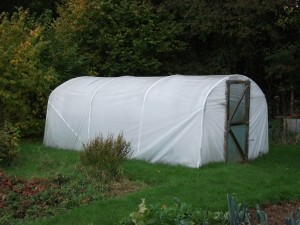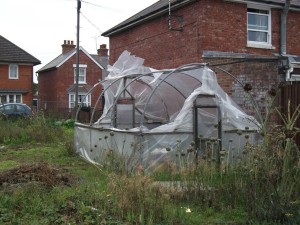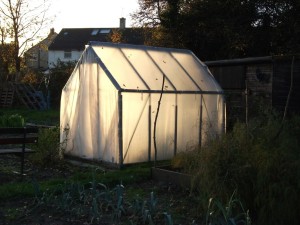What can I build on my allotment?
Of course, you aren’t allowed to build anything permanent on your allotment. Some sheds, greenhouses and polytunnels are permitted with the council's permission and if the structure falls within the council's guidelines. If you would like to add a structure to your plot you should get approval from the council by completing the form found here on their website.
SHEDS
You may have a shed up to 8ft x 6ft on your plot. For younger readers, this is 2.4m x 1.8m. It should not be more than 8ft high, but then it’s not going to be, is it? The tenant’s contract says you may erect a ‘toolhouse’ without permission; the council says you need permission for a shed. What is the difference between a toolhouse and a shed? The council says a toolhouse is a little shed just big enough to store your spades, rakes and so on. We think, by a ‘toolhouse’ they mean one of those sentry-box type things. If the shed you want is borderline, ask them.
GREENHOUSES
Same as sheds, maximum 8ft x 6ft (2.4m x 1.8m). But see below before buying or erecting a greenhouse!
Picture
POLYTUNNELS

Should be no longer than 15ft, no wider than 10ft, and no higher than 8ft. That is 4.5m long, 3m wide and 2.4m high. Polytunnels can be bought readymade, or created from materials you buy or “acquire”. If you are DIYing your polytunnel, DO invest in proper horticultural polythene which lasts at least 5 years.

Whatever you build, it should, according to what we’ve been told in the past, be at least 2ft (60cm) away from any boundary. It isn’t entirely clear, but we’ve always interpreted that to mean “away from the boundary of the site as whole”, NOT 2ft away from the boundary of your plot, which would be pointless.
A nice neat polytunnel – note how there is room to walk between it and the hedge behind.
Some common sense rules
A shed can serve many functions. As well as storing tools, it can shelter you from the rain or even, with a hastily-grabbed bucket, serve duty as an emergency convenience. Choose something reasonably sturdy and fit a strong padlock. Check the fitting supplied can’t simply be unscrewed without removing the padlock! Thefts from sheds tend to go in bursts; nothing for ages then a flurry all at once. Think twice before trusting anything expensive, such as a rotovator, to your shed. See the page on security.
A greenhouse on an allotment is always more vulnerable than one in a back garden. Before putting up a glass greenhouse, ask yourself whether it can be seen from any public footpath or playing fields. If it can be, we would strongly recommend using something with no glass. There have been instances in the recent past of youths with catapults or air rifles targeting greenhouses. It isn’t so much the expense, it’s the clearing up afterwards! No use wailing about the ‘youth of today’ – remember your old Dennis the Menace comics, or Just William!

If your plot butts up against a private garden – in many places allotments back onto housing – then you must leave room for the householder to get round to maintain their fence or hedge. That’s why it says ‘leave 2ft’. In practice, many people’s attitude to the other side of their hedge is that it is not their problem. If you are dealing with a normal height hedge, keeping it clipped on your side is the most sensible answer. Remember, the householder has no legal reason to come onto the allotments except to maintain their boundary – something that by custom and practice has usually been considered OK.
Occasionally a neighbour who is of an argumentative disposition will give a plotholder grief about boundary issues. If it is clear that you cannot calm things down by being polite, helpful and reasonable yourself -and do be all of those things, mind! – then the matter needs to be referred to the council, who are the landlords. Problems with overhanging trees, too-tall hedges or neighbours who throw their garden rubbish over their fence onto the plots also all need to go through the council – don’t get embroiled in a conflict yourself!